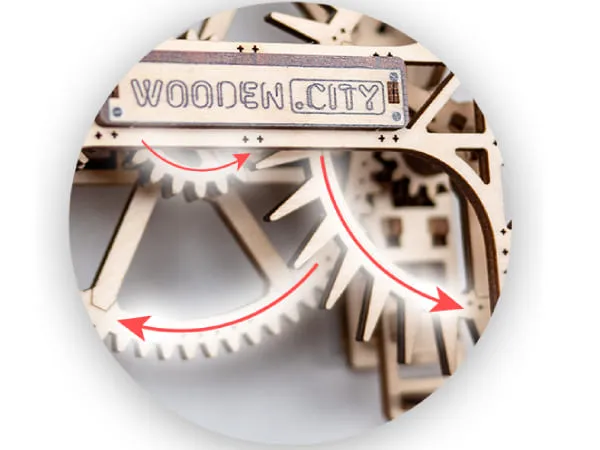1. Are 3D puzzles good for your brain?
Yes, 3D puzzles can be beneficial for your brain. They stimulate cognitive functions such as problem-solving, spatial reasoning, and fine motor skills. Engaging with 3D puzzles challenges your brain and can improve your memory and concentration.
2. How do 3D puzzles work?
3D puzzles typically consist of interlocking pieces that, when assembled correctly, form a three-dimensional model or structure. Each piece is designed to fit together in a specific way, often with the help of tabs, slots, or connectors, creating a sturdy and cohesive final product.
3. Should you glue a 3D puzzle?
Whether or not to glue a 3D puzzle depends on personal preference. Some people choose to glue their puzzles together to preserve them as display pieces, while others prefer to keep them disassembled for future enjoyment. If you decide to glue your puzzle, choose a specialized puzzle glue or a clear-drying craft glue for best results.
4. Are wooden puzzles good?
Yes, wooden puzzles can be excellent for both children and adults. They are durable, environmentally friendly, and often feature beautifully crafted designs. Wooden puzzles also provide tactile sensory experiences and can promote hand-eye coordination and problem-solving skills.
5. Do puzzles increase IQ?
While puzzles can enhance cognitive skills and mental agility, there’s no direct evidence to suggest that they increase IQ. IQ is influenced by various factors, including genetics, education, and environment. However, regularly engaging in activities like puzzles can contribute to overall brain health and development.
6. What material are 3D puzzles made of?
3D puzzles can be made from various materials, including cardboard, plastic, foam, and wood. Each material offers its unique characteristics, such as flexibility, durability, or aesthetic appeal, catering to different preferences and skill levels.
7. How long does it take to do a 3D puzzle?
The time it takes to complete a 3D puzzle varies depending on factors such as the puzzle’s size, complexity, and individual skill level. Smaller and simpler puzzles may be completed in a few hours, while larger or more intricate ones could take several days or even weeks to finish.
8. How to make a 3D puzzle?
Making a 3D puzzle typically involves designing a three-dimensional model, breaking it down into smaller components, and creating interlocking pieces that fit together seamlessly. The process may vary depending on the materials used and the complexity of the puzzle.
9. What to do with puzzles once finished?
Once finished, you can display your completed puzzles as decorative items, disassemble them for future use, or even frame them as wall art. Some people choose to donate or exchange completed puzzles with friends or family members to spread the enjoyment.
10. Are 1,000-piece puzzles hard?
A 1,000-piece puzzle can be challenging, especially for beginners or those not accustomed to working on larger puzzles. However, the difficulty level ultimately depends on individual skill, experience, and the complexity of the puzzle’s design.
11. Why are puzzles so expensive?
The cost of puzzles can vary depending on factors such as the quality of materials, intricacy of design, and brand reputation. Higher-quality puzzles made from premium materials may be more expensive due to increased production costs and craftsmanship.
12. What is a 3D puzzle?
A 3D puzzle is a puzzle that forms a three-dimensional model or structure when assembled correctly. Unlike traditional flat puzzles, 3D puzzles require assembling multiple pieces to create a tangible object, often replicating famous landmarks, vehicles, or architectural marvels.
13. What age are wooden puzzles for?
Wooden puzzles are suitable for a wide range of ages, from children to adults. Manufacturers often label puzzles with recommended age ranges based on complexity and safety considerations, but ultimately, suitability depends on individual preferences and developmental stages.
14. What is the price of a wooden puzzle?
The price of a wooden puzzle can vary depending on factors such as size, complexity, brand, and craftsmanship. Basic wooden puzzles may be relatively inexpensive, while larger or intricately designed ones could cost more due to higher production costs and quality materials.
15. What personality type likes puzzles?
People with a variety of personality types can enjoy puzzles, but they may particularly appeal to individuals who are detail-oriented, patient, and enjoy problem-solving activities. Puzzles can also be a favorite pastime for those who appreciate challenges and creativity.
16. Are 3D puzzles more difficult?
The difficulty of 3D puzzles varies depending on factors such as size, complexity, and individual skill level. While some 3D puzzles may be more challenging due to their intricate designs and assembly process, others can be relatively straightforward and enjoyable for beginners.
17. Are wooden puzzles better?
Whether wooden puzzles are better than puzzles made from other materials depends on individual preferences and intended use. Wooden puzzles are often praised for their durability, aesthetic appeal, and tactile sensory experiences, making them a popular choice for many puzzle enthusiasts.
18. How do you keep wooden puzzles together?
To keep wooden puzzles together, you can use specialized puzzle glue or clear-drying craft glue to secure the pieces in place. Alternatively, you can frame the completed puzzle or store it in a protective case or box to prevent pieces from becoming dislodged or lost.
